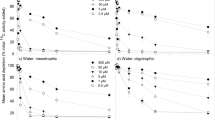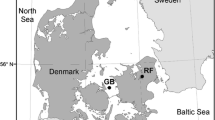Abstract
The bioavailabilities of dissolved organic carbon (DOC) and dissolved organic nitrogen (DON) were examined in eight sampling stations of the Heilongjiang watershed, located in Heilongjiang Province, northeast China. Water samples were incubated for 55 days at 20 °C, and the decreases in the DOC and DON concentrations were measured during the laboratory incubations. The experiments showed that bioavailable DOC (BDOC) accounted for 15–30 % of DOC and bioavailable DON (BDON) accounted for 29–57 % of DON. DOM bioavailability was higher for DON compared to DOC, suggesting that DON was more bioavailable and had a faster turnover than DOC in the Heilongjiang watershed. Furthermore, the percent of bioavailable DOC (%BDOC) was significantly related to SUVA254, not the DOC concentration, suggesting that the chemistry composition of DOM played a more important role in affecting its bioavailability compared to the DOM concentration. In addition, significant negative correlations were observed between the initial DOC/DON ratios and the percent of bioavailable DOM fractions (%BDOC and %BDON), especially for %BDON, implying that low C/N molecules or N-rich compounds may be preferentially utilized by microbes.

DOC concentrations of eight sampling sites, microbial decomposition of DOC over 55 days, % bioavailable DOC of eight sampling sites, DOM chemical composition of eight sampling sites, demonstrated chemical composition influence on DOM bioavailability.





Similar content being viewed by others
References
Aitkenhead-Peterson, J. A., McDowell, W. H., & Neff, J. C. (2003). Sources, production, and regulation of allochthonous dissolved organic matter inputs to surface waters. In S. E. G. Findlay & R. L. Sinsabaugh (Eds.), Aquatic ecosystems: interactivity of dissolved organic matter (pp. 25–70). Amsterdam: Academic Press.
Amon, R. M. W., & Benner, R. (1996). Bacterial utilization of different size classes of dissolved organic matter. Limnology and Oceanography, 41, 41–51.
Asmala, E., Autio, R., Kaartokallio, H., Pitkänen, L., Stedmon, C. A., & Thomas, D. N. (2013). Bioavailability of riverine dissolved organic matter in three Baltic Sea estuaries and the effect of catchment land-use. Biogeosciences, 10, 6969–6986.
Benner, R., & Opsahl, S. (2001). Molecular indicators of the sources and transformations of dissolved organic matter in the Mississippi River plume. Organic Geochemistry, 32, 597–611.
Bertilsson, S., & Jones, J. B. (2003). Supply of dissolved organic matter to aquatic ecosystems: autochthonous sources. In S. E. G. Findlay & R. L. Sinsabaugh (Eds.), Aquatic ecosystems: interactivity of dissolved organic matter (pp. 3–24). Amsterdam: Academic Press.
Bronk, D. A., & Glibert, P. M. (1993). Application of a 15N tracer method to the study of dissolved organic nitrogen uptake during spring and summer in Chesapeake Bay. Marine Biology, 115, 501–508.
Brookshire, E. N. J., Valett, H. M., Thomas, S. A., & Webster, J. R. (2005). Coupled cycling of dissolved organic nitrogen and carbon in a forest stream. Ecology, 86, 2487–2496.
Brophy, J. E., & Carlson, D. J. (1989). Production of biologically refractory dissolved organic carbon by natural seawater microbial populations. Deep-Sea Research, 36, 497–507.
Campbell, J. L., Hornbeck, J. W., McDowell, W. H., Buso, D. C., Shanley, J. B., & Likens, G. E. (2000). Dissolved organic nitrogen budgets for upland, forested ecosystems in New England. Biogeochemistry, 49, 123–142.
del Giorgio, P. A., & Davis, J. (2003). Patterns in dissolved organic matter lability and consumption across aquatic ecosystems. In S. E. G. Findlay & R. L. Sinsabaugh (Eds.), Aquatic ecosystems: interactivity of dissolved organic matter (pp. 399–424). London: Academic Press.
Fellman, J. B., D’Amore, D. V., Hood, E., & Boone, R. D. (2008). Fluorescence characteristics and biodegradability of dissolved organic matter in forest and wetland soils from coastal temperate watersheds in southeast Alaska. Biogeochemistry, 88, 169–184.
Findlay, S., Quinn, J. M., Hickey, C. W., Burrell, G., & Downes, M. (2001). Effects of land use and riparian flowpath on delivery of dissolved organic carbon to streams. Limnology and Oceanography, 46, 345–355.
Findlay, S. E. G., & Sinsabaugh, R. L. (2003). Aquatic ecosystems: interactivity of dissolved organic matter. Amsterdam: Academic Press.
Glibert, P. M., Harrison, J., Heil, C., & Seitzinger, S. (2006). Escalating worldwide use of urea—a global change contributing to coastal eutrophication. Biogeochemistry, 77, 441–463.
Glibert, P. M., Magnien, R., Lomas, M. W., Alexander, J., Fan, C., Haramoto, E., et al. (2001). Harmful algal blooms in the Chesapeake and Coastal Bays of Maryland, USA: comparison of 1997, 1998, and 1999 events. Estuaries, 24, 875–883.
Herbland, A., Le Bouteiller, A., & Raimbault, P. (1985). Size structure of phytoplankton biomass in the equatorial Atlantic Ocean. Deep-Sea Research, 32, 819–836.
Inamdar, S., Finger, N., Singh, S., Mitchell, M., Levia, D., Bais, H., et al. (2012). Dissolved organic matter (DOM) concentration and quality in a forested mid-Atlantic watershed, USA. Biogeochemistry, 108, 55–76.
Inamdar, S. P., & Mitchell, M. J. (2007). Storm event exports of dissolved organic nitrogen (DON) across multiple catchments in a glaciated forest watershed. Journal of Geophysical Research: Biogeosciences, 112, G02014. doi:10.1029/2006JG000309.
Jaffé, R., McKnight, D., Maie, N., Cory, R., McDowell, W. H., & Campbell, J. L. (2008). Spatial and temporal variations in DOM composition in ecosystems: the importance of long-term monitoring of optical properties. J Geophysical Res: Biogeosciences, 113, G04032. doi:10.1029/2008JG000683.
Kalbitz, K., Schmerwitz, J., Schwesig, D., & Matzner, E. (2003). Biodegradation of soil-derived dissolved organic matter as related to its properties. Geoderma, 113, 273–291.
Kang, P.-G., & Mitchell, M. J. (2013). Bioavailability and size-fraction of dissolved organic carbon, nitrogen, and sulfur at the Arbutus Lake watershed, Adirondack Mountains, NY. Biogeochemistry, 115, 213–234.
Kaushal, S. S., & Lewis, W. M. (2005). Fate and transport of organic nitrogen in minimally disturbed montane streams of Colorado, USA. Biogeochemistry, 74, 303–321.
Kerner, M., Hohenberg, H., Ertl, S., Reckermann, M., & Spitzy, A. (2003). Self-organization of dissolved organic matter into micelle-like microparticles in river water. Nature, 422, 150–154.
Kortelainen, P., Saukkonen, S., & Mattsson, T. (1997). Leaching of nitrogen from forested catchments in Finland. Global biogeochemical cycles, 11, 627–638.
Lønborg, C., Davidson, K., Álvarez-Salgado, X. A., & Miller, A. E. J. (2009). Bioavailability and bacterial degradation rates of dissolved organic matter in a temperate coastal area during an annual cycle. Marine Chemistry, 113, 219–226.
Marschner, B., & Kalbitz, K. (2003). Controls on the bioavailability and biodegradability of dissolved organic matter in soils. Geoderma, 113, 211–235.
Neff, J. C., Chapin, F. S., III, & Vitousek, P. M. (2003). Breaks in the cycle: dissolved organic nitrogen in terrestrial ecosystems. Frontiers in Ecology and the Environment, 1, 205–211.
Petrone, K. C., Richards, J. S., & Grierson, P. F. (2009). Bioavailability and composition of dissolved organic carbon and nitrogen in a near coastal catchment of south-western Australia. Biogeochemistry, 92, 27–40.
Qualls, R. G., & Haines, B. L. (1992). Biodegradability of dissolved organic-matter in forest throughfall, soil solution, and stream water. Soil Science Society of America Journal, 56, 578–586.
Saadi, I., Borisover, M., Armon, R., & Laor, Y. (2006). Monitoring of effluent DOM biodegradation using fluorescence, UV and DOC measurements. Chemosphere, 63, 530–539.
See, J. H., Bronk, D. A., & Lewitus, A. J. (2006). Uptake of Spartina-derived humic nitrogen by estuarine phytoplankton in non-axenic and axenic culture. Limnology and Oceanography, 51, 2290–2299.
Seitzinger, S. P., & Sanders, R. W. (1999). Atmospheric inputs of dissolved organic nitrogen stimulate estuarine bacteria and phytoplankton. Limnology and Oceanography, 44, 721–730.
Seitzinger, S. P., Sanders, R. W., & Styles, R. (2002). Bioavailability of DON from natural and anthropogenic sources to estuarine plankton. Limnology and Oceanography, 47, 353–366.
Servais, P., Billen, G., & Hascoët, M. C. (1987). Determination of the biodegradable fraction of dissolved organic matter in waters. Water Research, 21, 445–450.
Søndergaard, M., Williams, P. J., le, B., Cauwet, G., Riemann, B., Robinson, C., Terzie, S., et al. (2000). Net accumulation and the flux of dissolved organic carbon and dissolved organic nitrogen in marine plankton communities. Limnology and Oceanography, 45, 1097–1111.
Sobzcak, W. V., & Findlay, S. (2002). Variation in bioavailability of dissolved organic carbon among stream hyporheic flowpaths. Ecology, 83, 3194–3209.
Sun, L., Perdue, E. M., Meyer, J. L., & Weis, J. (1997). Use of elemental composition to predict bioavailability of dissolved organic matter in a Georgia River. Limnology and Oceanography, 42, 714–721.
Weishaar, J. L., Aiken, G. R., Bergamaschi, B. A., Fram, M. S., Fujii, R., & Mopper, K. (2003). Evaluation of specific ultraviolet absorbance as an indicator of the chemical composition and reactivity of dissolved organic carbon. Environmental Science & Technology, 37, 4702–4708.
Wetzel, R. G. (2001). Limnology: lake and river ecosystems, 3rd ed. Academic Press
Wiegner, T. N., & Seitzinger, S. P. (2004). Seasonal bioavailability of dissolved organic carbon and nitrogen from pristine and polluted freshwater wetlands. Limnology and Oceanography, 49, 1703–1712.
Wiegner, T. N., Seitzinger, S. P., Glibert, P. M., & Bronk, D. A. (2006). Bioavailability of dissolved organic nitrogen and carbon from nine rivers in the eastern United States. Aquatic Microbial Ecology, 43, 277–287.
Wikner, J., Cuadros, R., & Jansson, M. (1999). Differences in consumption of allochthonous DOC under limnic and estuarine conditions in a watershed. Aquatic Microbial Ecology, 17, 289–299.
Yamashita, Y., Maie, N., Briceno, H., Jaffé, R. (2010). Optical characterization of dissolved organic matter in tropical rivers of the Guayana Shield, Venezuela. Journal of Geophysical Research: Biogeosciences, 115, G00F10. doi:10.1029/2009JG000987
Acknowledgments
This work was financially supported by the Major Projects on Control and Rectification of Water Body Pollution (2009ZX07106-001), the Science and Technology Support Projects on the National Environmental Monitoring and Information (2111101), and the Projects on Control and Rectification of Water Body Pollution-the Cross-Border Aquatic Environment Investigation and Policy Research (2039001001011).
Author information
Authors and Affiliations
Corresponding author
Additional information
Highlights
Time series of DOC and DON during the bioassay experiment were investigated.
Bioavailability of DOC and DON was measured to understand the C and N cycles.
Identify the chemical composition was a major factor affecting its bioavailability.
Show low C/N molecules compounds may be preferentially utilized by microbes.
Rights and permissions
About this article
Cite this article
Shi, J., Cui, H., Jia, L. et al. Bioavailability of riverine dissolved organic carbon and nitrogen in the Heilongjiang watershed of northeastern China. Environ Monit Assess 188, 113 (2016). https://doi.org/10.1007/s10661-016-5120-y
Received:
Accepted:
Published:
DOI: https://doi.org/10.1007/s10661-016-5120-y




